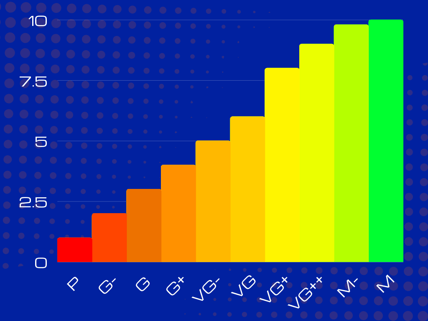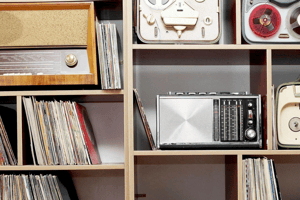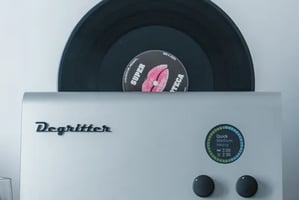Originally published April 4, 2019
AAGS Grading and Scoring Index Explained
.png?width=594&height=322&name=Copy%20of%20AAGS%20Scoring%20Index%20and%20Certificate%20Explained%20(1).png)
The need for a vinyl record grading authority
One of the most challenging parts of purchasing and collecting vinyl records is having a reliable way of knowing precisely what the condition of an album is without looking at it for ourselves. And even then, aside from visual inspections, how does it sound? Does it have all of the inserts? What is the actual condition of those inserts? Which pressing is it? What is the population of such a record; in other words, how many of this pressing and in this condition exist? Such questions pose a minimal risk on a low-cost record. However, if you have a vinyl record valued in the triple, quadruple, and even quintuple digits, having the questions above answered by a 3rd party gives you the confidence you need to invest in the album. From the seller's perspective, grading and certification help you sell the album faster and potentially add value to the record, which could lend itself to catching a premium. This is why the AAGS grading and scoring system was created.
But how does it work?
The AAGS grading system
(Note: this article references our encapsulation grading, however, our soft grading is based on tis process, however, is simplified.)
We base our grading decisions on the Goldmine grading standard. However, we go beyond just visually grading the record and the sleeve. The AAGS grading and scoring system features a multitude of inspection points. We feel such a thorough inspection provides a much more accurate grade. However, each record could have more than 15-25 inspection points. To make understanding the overall grade of a record simple, we distill the overall condition into a single score for the sleeve, the record, and the audio quality.
Visual inspection
We perform a visual inspection of the following:
Outer Jacket or Sleeve:
- Each corner
- All four edges (spines and record slot)
- Front surface
- Back surface
Vinyl Record:
- Grooves on each side
- Label
- Center hole
Sealed Records:
- Thorough inspection of the seal
Audible Grading (optional):
Listen to the record to determine the quality of the pressing, listen for groove damage and scratches, and note if any skips exist.
Additional inspection points
We determine if the submission is complete in sleeve (CIS). AAGS considers a submission CIS if the outer jacket or sleeve is present and the vinyl record is kept in an inner sleeve.
Suppose a specific release submitted was made available with an insert such as a custom-printed sleeve, poster, stickers, or another insert. In that case, we indicate if those inserts are present and call them album-specific inserts (ASI).
Although we do not grade these items individually, we note if they're present and indicate that information on the grading label.
Grading and Scoring
Each inspection point is individually graded based on the popular Goldmine standard and entered into the AAGS proprietary grading algorithm. The result is the AAGS index score, a scoring system that ranges from 1 (Poor) – 10 (MINT).
The chart below compares the AAGS scoring index with the Goldmine grading system. What is beautiful about the AAGS Index is that it factors the entire record condition into one number.
AAGS Index is that it factors the entire record condition into one number.
Certificate
In addition to the AAGS index score, each graded record receives a certificate. The certificate includes information such as the AAGS Index Score, the specific score for just the sleeve, the record, the shrink, and the audible grading depending on the submission. We also include basic information such as the artist and album name, indicate if the submission is CIS and if any ASIs are present. We have a scannable barcode for our processing, a QR code for submission-specific information, and a serial number linked to our database and links your submission to the population report.
We also indicate what options are included with your submission.
Options
All options are indicated on the label and will be accessible via the QR code with the AAGS mobile app (coming soon.)
Ultrasonic Cleaning
We will perform a six-step archival deep clean to get the best possible visual and, if requested, audible grade.
Sticker Removal
Suppose there is an annoying sticker on the shrink or directly on the jacket. In that case, our techs will surgically remove the sticker so that your submission looks its best AND receives the best score possible.
Shrink Cleaning
Sometimes a sealed record doesn't mean it's clean. There may be years of dirt, grime, and grit on the shrink wrap from living in the basement for all those years. We have special cleaning techniques to get the shrink as clean as possible before slabbing.
Photography Package
We will take up to 10 stunning photos of all elements of the submissions' contents. These photos can be used for online ad creation and for posterity.
Audible Grading
We set up your album in the AAGS listening room and analyze each side of the record. We note pressing defects, surface noise, groove damage, and defects due to warping. The audible grade index score is then printed on the label.
Conclusion
So vinyl record grading and slabbing is pretty cool, and we feel strongly that our scoring system answers a need in the collectibles market for store owners and collectors alike to have a reliable way for a 3rd party to grade records as a collectible. Give AAGS grading a try for yourself!
If you are interested in vinyl record encapsulation or any of our other services, please visit us at aagservices.org to learn more about how you can bring your collection to the next level! info@aagservices.org



